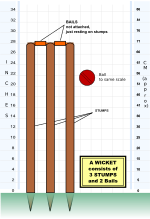Bail (cricket)
In the sport of cricket, a bail is one of the two smaller sticks placed on top of the three stumps to form a wicket.
The wicket is considered to be broken if one or both of the bails fall from the stumps, or a stump is struck out of the ground, by: This means, for example, that if the ball hits the wicket directly from the bowler's delivery, the batsman is only out bowled if a bail falls off, so a ball can actually brush or rest against the stumps without the batsman being dismissed (as long as the bail remains in its groove).
If a bail falls off the stumps for any other reason while the ball is still in play, and a later incident such as a ran out attempt requires the wicket to be broken, then the other bail can be removed (if it has not yet fallen off), or a stump can be struck out of the cricket ground or pulled up, as described above.
The large central cylinder is called the barrel and the smaller protrusions are the spigots.
The umpires can decide to dispense with the bails completely (for example, where strong gusts of wind would remove even the heavy bails), in which case the umpires will adjudge whether or not the wicket is broken, however, Hawk-Eye graphics, part of the Decision Review System, still assumes the bails are on the stump.

